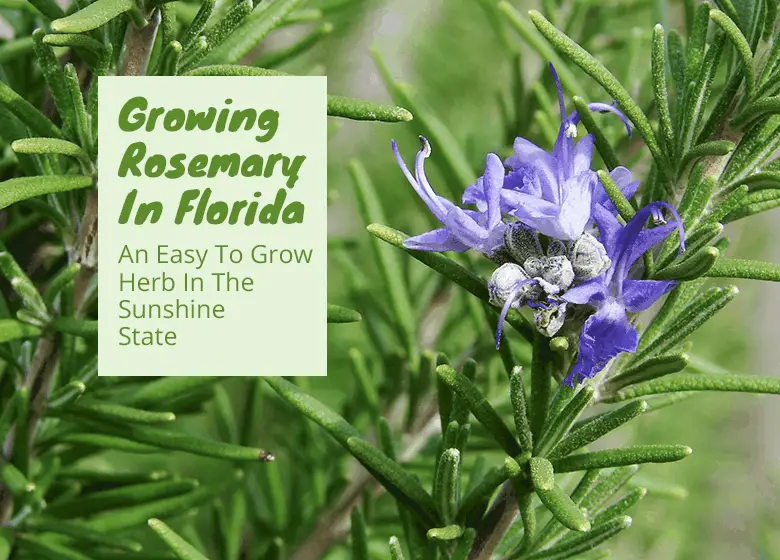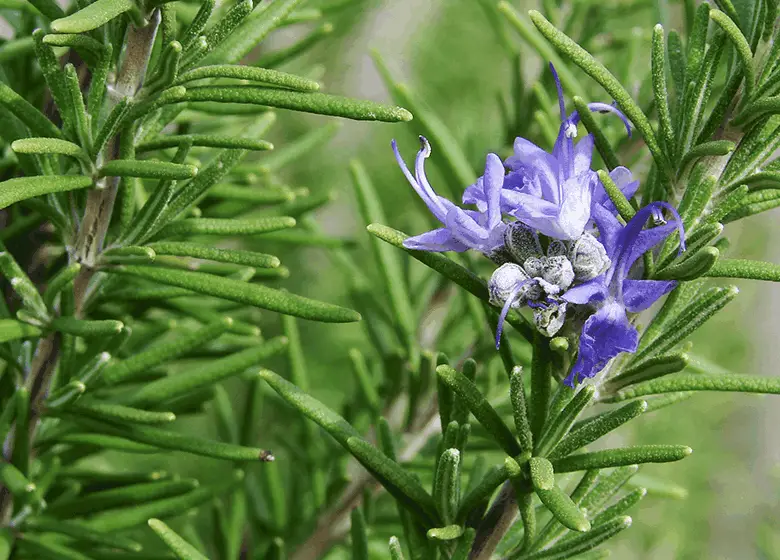
Growing Rosemary in Florida is a no brainer
Rosemary is among the easiest herbs to add to your Florida garden. It is a fantastic perennial. It can survive through a spell of drought, but it does not fare well in the colder weather of the northern part of Florida. In south and central Florida, the plant can be cultivated for years.
In the northern regions, the herb will die in the course of winter unless it is planted in a container that can be relocated indoors. Rosemary blooms in spring and winter with small lavender, pink, or blue flowers.

Varieties of Rosemary
Rosemary comes in two primary types, namely the creeping and upright varieties.
Upright Rosemary
Upright rosemary is a woody shrub that is popularly grown for its edible attributes as well as its ornamental qualities.
It has needle-like leaves that are grayish green and which are harvested in the course of summer. The leaves emit a pungent fragrance and a sharp taste.
During early Spring lavender flowers bloom at the ends of branches. The leaves remain grayish green through winter. The upright rosemary appears as multi-stemmed and dense, and it has an upright spreading growth habit. Its less refined foliage make it stand out from other landscape plants.
Upright rosemary typically stands at 4 feet at maturity with a spread of around 3 feet. It grows at a medium rate, has a low canopy, and can live for about ten years.
Rosemary prefers average to dry moisture levels with well-drained soils in addition to full sunlight. It will die if kept in standing water, and it can withstand urban pollution. It can be cultivated in an edibles garden or flower or landscape gardens. Rosemary is also well-suited to grow in containers and outdoor pots.
Creeping Rosemary
Creeping rosemary had numerous garden and culinary uses. It is indigenous to Mediterranean countries but can also thrive in many US states, including Florida.
Creeping rosemary, once grown, layers and sows itself and will last for years and years. It is not as hardy as the upright variety, so it should be allocated warm, protected spaces.
It will soon break bounds, however, and smother neighboring plants. You need to make allowances for its ballooning exuberance since you will lose the plant’s charm if you cut off its edges.
It can easily spread to 4 to 8 feet if left unmanaged and it reaches a height of 1 ft. Creeping rosemary will thrive in most types of soil, as long as it is not sodden.
Planting Rosemary in Florida
Rosemary herbs are typically propagated by cuttings because it can be challenging to source seeds for germination. Look for cuttings in the community garden or ask a friend for some.

Clip off several 4-inch pieces from the plant. The ideal time to get the cuttings is in late spring although it can be done in early Autumn if you reside in the warmer parts of the state.
The plants that will sprout from the cutting will contain the same attributes as the original bush.
There are numerous rosemary varieties, and you can look online for different cuttings. Alternatively, you can get a small plant or seedling from a nursery.
Preparing A Rosemary Cutting
Before planting the plant, get rid of the leaves that are in the lower part of the cutting which is generally around an inch from the stem’s end. This part of the cutting is what goes into the soil. The leaves need to be cut because they will make the stem rot instead of growing.
Each cutting goes into a pot of soil containing one-third peat moss and two-thirds coarse sand. The pot should be put in a sunny place (not to be confused with direct sunlight).
Water the cuttings frequently and keep them in the warm area until the roots begin to form, which commonly takes three weeks. To facilitate the growth process, you can cover the pot with a plastic bag or cling wrap, and puncture some holes at the top to regulate temperature and maintain moist and warm conditions.
After the roots have developed, rosemary can be planted outdoors. It is quite sturdy, so it will thrive in a variety of conditions.
It can additionally be trained as a scented hedge.
The soil should drain well, and the more alkaline it is, the better the fragrance you will get.
Rosemary thrives with about 6 to 8 hours of full sun daily. It tolerates an extensive range of humidity and high temperatures.
Caring for Rosemary
Rosemary responds the best to drier soil, so refrain from over-watering. The standard garden watering will suffice. Our Florida rains should be sufficient enough to sustain rosemary without too much extra watering.
Rosemary does not need fertilizers, although it is wise to add some lime in the soil. You can add a kelp/fish emulsion in spring.
As much as rosemary is hardy, it will not come out of harsh winters unscathed. The branches commonly get damaged. To avoid this, you can move the plant indoors.
Taking the plant indoors presents its own kind of challenges. Poor air circulation and high humidity can result in powdery mildew. This fungus will weaken the plant. You can balance the humidity by letting the soil dry between waterings.
You can prune rosemary if need be. The bush can grow large and take up space in your garden.
Benefits and Uses of Rosemary
Harvest sprigs of the plant’s leaves as needed as it will continue growing. You can harvest it throughout the year since it is evergreen. The leaves can be kept in airtight jars to dry up.
The herb is quite popular in French and Italian cuisines for its warm spice. Full sprigs can be used for garnishing, finishing, and adding flavor. You can also add the herb to baked goods like bread and flavor your lemonade. Rosemary can also be used to make cooking oil, butter, and salt.
Rosemary has a ton of health benefits. It is a fantastic digestive aide. It supports the body’s ability to digest such large proteins as those contained in grain, meat, and dairy.
A cup of rosemary tea will relieve blood sugar concerns, bloating, and pain. The tea will also address minor aches like a mild headache. If you want a solution to thinning hair, you can add rosemary tea to homemade shampoo. It is also a noted super herb when it comes to memory, stress, and anxiety.
Rosemary oil is incredibly popular as an anti-fungal, antiseptic, antiviral, anti-bacterial product as well as being a cough-suppressant.
Rosemary Is An Easy Herb To Grow In Florida
- Growing rosemary in Florida is easy
- Plant in Spring for all parts of the state. In central and south Florida you can also plant in the fall
- There are two main types of rosemary, upright and creeping
- Plant in an area that gets about 6-8 hours of sun
- Plant in well-draining soil
- Buy a plant from a nursery or get cuttings from somebody you know. Seeds have a low germination rate
You might also be interested in:


